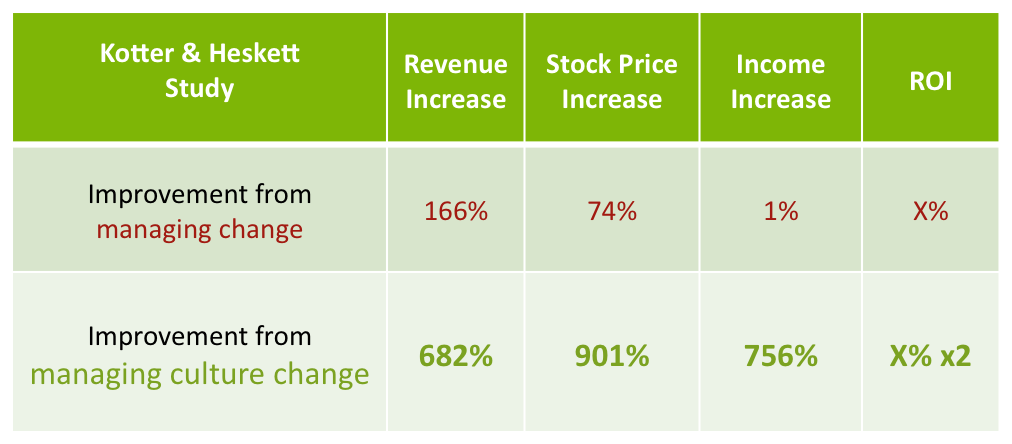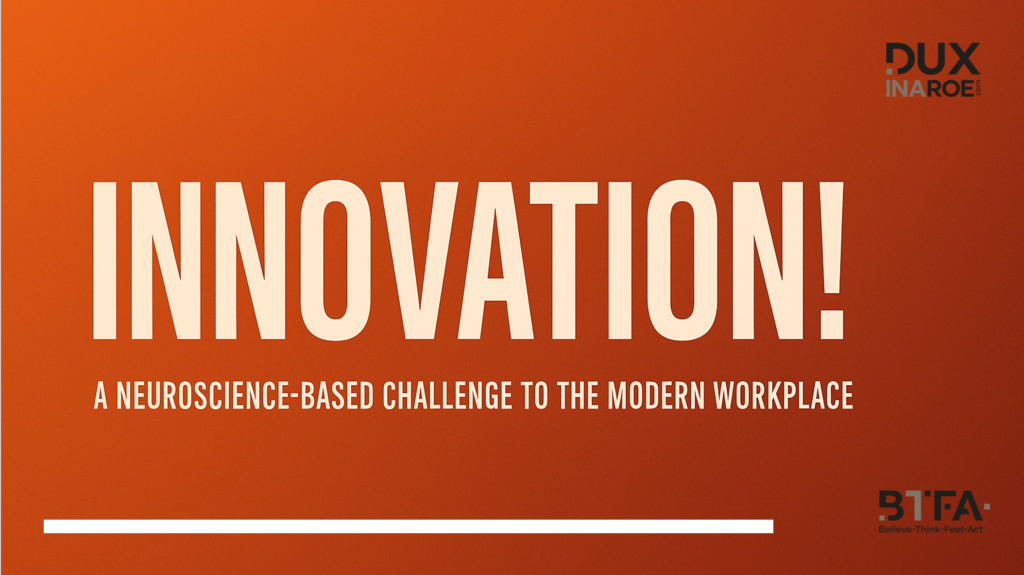“Innovation!”, like “engagement,” “ownership,” and “culture change”, is one of those buzzwords that falls under the “soft skills” banner but proves devilishly hard to get right. Ironic, isn’t it?
So, what exactly is ‘Innovation’?
Let’s unpack this in a way we rarely do in business: by using root cause thinking, not the usual 5 Whys, but 5 “What Is?” questions.
- What is Innovation? It’s the act of introducing something new or original, a behaviour or idea that disrupts or improves a system, society, or market.
- What is a ‘new act’? It’s a behaviour not previously performed, a response to a unique stimulus or condition.
- What is behaviour? A response to a stimulus; the way a person or system reacts.
- What is a response? A nerve impulse, an electrical signal triggered by internal or external change.
- What is a nerve impulse? An electrochemical signal within the brain and body, the raw currency of all human activity.
In essence:
Innovation is a series of neural responses to conditions, resulting in novel thoughts, translated into novel actions.
The Real Question for Leaders
If innovation originates in the brain, then we must ask: What conditions encourage the kinds of neuronal firing that produce original thought? Or more precisely: What conditions make innovative thinking both likely and actionable?
That’s where things get uncomfortable. Because most workplace environments, despite their posters and pep talks, are unconsciously designed to suppress, not support, these conditions.
Innovation Begins Where Fear Ends
Innovation demands cognitive flexibility and pattern-breaking insight. But fear, one of the most prevalent workplace emotions, (due to worries at home, the boss, the system, hitting targets, change, projects, messages from multiple tech platforms etc.), does just the opposite. Under stress, the brain’s glucose (its fuel) is redirected from the prefrontal cortex (used for logical thought, creativity, and decision-making) to the amygdala, the seat of our fear response. This triggers the fight/flight system and shuts down rational thinking.
This isn’t metaphorical. It’s biology.
The more chronic the fear (performance targets, ambiguous hierarchies, KPI pressure), the more cortisol and adrenaline are released. Over time, this hormonal cocktail suppresses Brain-Derived Neurotrophic Factor (BDNF), essential for neurogenesis and learning. Without BDNF, your people can’t learn from mistakes, connect dots across experiences, or imagine better ways of working.
So if innovation requires thought, and fear inhibits thought, then the math is simple:

Yet most organisations inadvertently design for fear.
ERP systems, rigid KPIs, absurd timelines, performance reviews framed as threats, all these build a culture of learned helplessness, cognitive dissonance, and error-prone behaviour. Ironically, these are often presented as best practice.
As we’ve seen through our BTFA work with companies across sectors, the systems intended to improve productivity often erode the very neural conditions needed for sustained, creative performance.
The Brain’s Innovation State: Not Where You Think
When do people most often experience “Ah-ha!” moments?
Not in boardrooms. Not in brainstorms. But while driving, walking, vacuuming, showering, or relaxing in a bath (just ask Archimedes).
Why?
Because in these moments, our prefrontal cortex rests. We shift from Beta brainwaves (conscious effort) to Alpha and Theta (relaxed, meditative states). This creates space for the brain’s Default Mode Network to engage, cross-referencing memories, processing experience, and making previously unseen connections. These are the neural conditions that support true innovation.

Neuroimaging studies show that activity increases in the precuneus, parahippocampal gyrus, posterior cingulate cortex, and other memory-integration regions during these states. These areas light up not when we’re pushing for answers, but when we let go. It’s why many brilliant ideas feel like they “just arrived.” They didn’t, they were built in silence.
In other words, the brain innovates best when it’s left alone, safe, unthreatened, and unforced.
So Why Do Organisations Get This So Wrong?
Because traditional leadership models evolved in the absence of any neuroscience.
They were forged during an industrial age built on control, hierarchy, and power, not understanding. Leaders have long been taught to focus on outputs (P&L, forecasts) rather than the inputs (psychological safety, neurobiological readiness, intrinsic motivation).
The result? Workplaces that systematically oppose the brain’s ability to be creative, curious, or calm.
Instead of cultivating the conditions that generate breakthrough thinking, we deploy change programs based on the same flawed assumptions: tighten controls, incentivise with fear, demand outcomes. And then wonder why the results disappoint and change slips back over time.
The Data Already Proves the Point
Back in the 1990s, Kotter & Heskett’s landmark study on corporate culture and performance tracked 207 firms over 11 years. The companies that focused on culture change, long before we had brain scans to validate their methods, achieved astonishing outcomes:
4x revenue growth, 12x stock price improvement!

Why? Because some leaders, (those Jim Collins – Author of ‘Good to Great’ – might call “Level 5 Leaders”), intuitively created the conditions in which brains perform best.
And now?
We have the science to explain why they succeeded, and to replicate it, deliberately!!
You Can’t Innovate While Afraid
Let’s anchor this in the everyday.
Imagine this: (true story) … my wife’s friend, juggling shopping bags, has her knicker elastic snap in public. Panic sets in. She bolts to her car, frantically jabbing the unlock button, but the car won’t open. Because it’s not her car.
Her brain, in that moment, did what stressed brains do: shut down logic, fuel defence, and default to habit. Her prefrontal cortex was offline. Her brain wasn’t solving problems; it was protecting her from embarrassment.
This minor event mimics what happens in workplaces across the world, daily.
When people live in chronic low-grade stress, they make basic errors, struggle to learn, misread signals, and disconnect from organisational vision. This isn’t a character flaw. It’s the neurobiology of cortisol, glucose redirection, and amygdala dominance.
And it’s killing your performance, across safety, quality, cost, delivery, and growth.
The Innovation Paradox
Businesses claim to want innovation, engagement, and ownership. But they create conditions that guarantee the opposite.
- Fear of failure kills curiosity.
- Over-automation kills agency.
- Micromanagement kills learning.
- Chronic pressure kills brain cells.
And then we bring in external consultants to launch “change initiatives” that replicate the same failing conditions, only with new labels.

So, What Do We Do Instead?
We start by accepting a simple but radical premise:
The human brain is the source of all innovation. So leadership must become the science of creating the conditions in which that brain can thrive.
This means:
- Replacing threat-based leadership with respect-based leadership.
- Understanding the link between freedom, clarity, and neurological safety.
- Designing systems that align with how humans actually learn, adapt, and create.
The BTFA framework (Believe–Think–Feel–Act), developed through decades of applied neuroscience, provides leaders with exactly that roadmap. It links soft skills to hard science, turning vague ideals like culture change and innovation into predictable, observable neural shifts. It’s the reason we’ve seen companies using BTFA to guide their approach, achieve up to £410m ROI from brain and behaviour-led transformation.
In Closing
There is no shortcut.
If you’re serious about innovation, you must take on the uncomfortable complexity of human behaviour, neurobiology, psychology, and systems thinking. It isn’t easy, but it’s far easier than dealing with the cost of failure that 85% of change initiatives suffer … or wondering why you’re part of the the global avg. 79% disengagement level statistics, the current beliefs in leadership have led to.
Leadership in the 21st century isn’t about knowing the answer. It’s about knowing how to create conditions that allow the answer to emerge.
And that… might just be the most innovative thought of all.
This is the first in a series of articles I’ll share weekly through the summer of 2025, digging into the so called ‘soft’ skills the accepted and broadly promoted approach to leadership seems to find so hard to leverage effectively or efficiently.
This article is a rewrite of a post I put out in 2013. Unfortunately, the view of innovation as a neurological process has not, as yet, become popular in a world where the prevailing belief behind decisions and actions are flooded by logic, systems and technology, more than biology.
#BTFA is an online leadership development experience from Duxinaroe Ltd that is being deployed with brilliant results globally – get in touch to see how it can help you address your most pressing issues.

